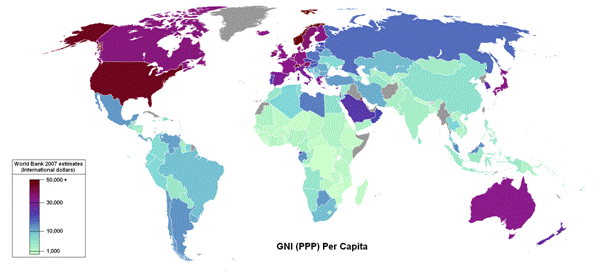Comparing welfare - more on Purchasing Power Parity
You need to be able to:
Compare and contrast GDP per capita figures and GDP per capita figures at purchasing power parity (PPP) exchangerates for economically more developed countries and economically less developed countries.
We saw in the previous section that GDP alone is not a completely
adequate measure of the standard of living, though it is often used as
a proxy for it.
If we do use GDP as a measure of standard of living, then we also need to take account of differences between the purchasing power of GDP. If you have travelled much, you will be aware that prices of goods in other countries often appear cheaper / more expensive. This may appear the case to us as tourists, but not always to the people living there. This may be the case for a number of reasons. Certainly, changes in the exchange rate will affect purchasing power of foreign visitors, but other economic factors are at play too.
It may be that a lower GDP per capita will provide the same standard
of living compared to a country with a higher GDP per capita, because
the same level of income can buy more in the first country - in other
words real prices are lower.
So when comparing GDP between countries it is necessary to adjust for the purchasing power of the GDP. Differences in purchasing power often relate to exchange rate differentials. Although purchasing power is one factor affecting exchange rates, there are many others as well and a country's exchange rate may well be out of line with what is called the purchasing power parity (PPP) exchange rate.
Purchasing power parity (PPP) exchange rates are used for currency conversion allowing for differences in price levels between countries. Normally they are given in national currency units per US dollar. We begin the process by identifying a set basket of goods (or even a Big Mac) and comparing the cost of this basket between countries and then using this comparison to adjust the official exchange rate.
If, for example, this basket costs $100 in the US and 1000 rupees in India; it would indicate that one dollar provides exactly the same purchasing power as 10 rupees. The purchasing power parity (PPP) exchange rate is, therefore, defined as US$1=10 rupees.
This method more accurately compares incomes across countries. It converts income in each country from that country's domestic currency to US dollars using purchasing power parities rather than the usual method of using official exchange rates or market exchange rates. Purchasing power parity adjusts official exchange rates for cost-of-living differences between the US and the country in question.
When comparing GDP levels we should always compare GDP per capita translated at purchasing power parity rates.

GNI per capita (purchasing power parity) 2007

You may find the following world Bank publication helpful in understanding purchasing power parity.
